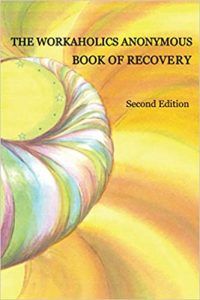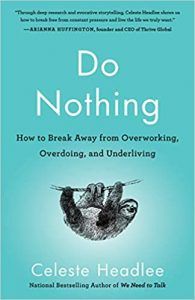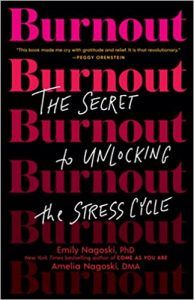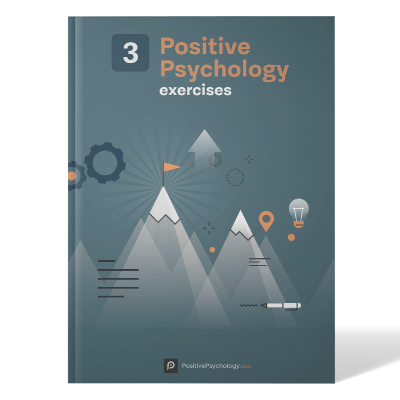Helping a Workaholic in Therapy: 18 Symptoms & Interventions
 Have you clocked over 50 hours at work this week? Are you a self-confessed workaholic?
Have you clocked over 50 hours at work this week? Are you a self-confessed workaholic?
As it turns out, working long hours isn’t enough to call yourself a workaholic.
However, add a constant preoccupation with thinking about work to the point where it detracts from anything else, and this raises a workaholic red flag.
Helping a workaholic is not as simple as implementing strategies to spend less time at work; it requires support to reframe thoughts and help to dissociate a sense of self-worth and value from work performance.
Read this article to learn more about problematic signs, symptoms, and personality traits common to workaholics, tools to help recognize a workaholic, and interventions and resources to support recovery – and perhaps even knock off work early on a Friday.
Before you start reading, we thought you might like to download our three Stress & Burnout Prevention Exercises (PDF) for free. These science-based exercises will equip you and those you work with, with tools to manage stress better and find a healthier balance in your life.
This Article Contains:
- What Is a Workaholic? 12 Problematic Signs and Symptoms
- Workaholics According to Psychology
- Helping a Workaholic in Therapy
- 6 Best Interventions to Help Workaholics
- Tests & Quizzes to Assess the Signs
- 4 Self-Care Books for Helping Workaholics
- Helpful Resources From PositivePsychology.com
- A Take-Home Message
- References
What Is a Workaholic? 12 Problematic Signs and Symptoms
The construct of workaholism, derived from the analogy to alcoholism, was first defined in the 1970s as “addiction to work, the compulsive and uncontrollable need to work incessantly” (Oates, 1971).
Early on, workaholics were often characterized as those who worked more than 50 hours per week, but the term has since evolved to consider not just time spent at work, but the attitude about and mental preoccupation with work (Andreassen, 2014).
Most contemporary definitions characterize a workaholic as someone who displays a problematic, irresistible preoccupation or obsession with work and who has an uncontrollable urge to invest time and effort into work activities beyond expectations (Balducci, Spagnoli, & Clark, 2020).
Signs and symptoms of a workaholic may include:
- Working long hours, over and above what is expected or needed.
- Constantly thinking and talking about work.
- Intrusive thoughts about work when attempting to engage in other activities.
- Revolving life around work, such as prioritizing or considering work schedules or commitments when making non-work decisions or plans.
- A subjective loss of control, to the point where it feels impossible not to engage in work despite insight or acknowledgment of negative consequences.
- Deliberately or inadvertently prioritizing work over other core basic needs, including depriving self of sleep, exercise, good nutrition, spending time with others, or engaging in hobbies or relaxation.
- A lack of significant healthy relationships or hobbies outside of work.
- A lack of enjoyment from tasks that do not involve work, due to feeling too preoccupied to be fully engaged.
- An inability to switch off and be present, constantly plagued with thoughts related to work.
- Using work to avoid or cope with discomfort associated with relationships, grief, trauma, guilt, depression, or significant life events such as death or divorce.
- Perfectionistic tendencies, whereby extremely high standards are held for the self and others in terms of work effort and performance.
- Obsession with work-related success, often experiencing paranoia or intense fear of work failure.
Workaholism has been associated with burnout, depression, poor physical health, career and life dissatisfaction, work–family conflict, and relationship and marital conflict (Quinones & Griffiths, 2015).
Workaholics who love their job (often described as ‘engaged workaholics’ in the literature) may be somewhat protected from the most severe consequences but still share common negative effects (Loscalzo & Giannini, 2017).
Workaholics According to Psychology

However, there is some agreement that workaholism represents a significant psychological dysfunction, synonymous with a true addiction (Andreassen, 2014; Atroszko, Demetrovics, & Griffiths, 2020).
In line with addiction theories, workaholics are understood to be driven by inherent intrinsic motivational and personality factors.
Theoretical models such as the trait theory approach have been used to identify several personality factors representative of workaholics: obsessive-compulsive traits, achievement orientation, perfectionism, and conscientiousness (Liang & Chu, 2009).
Obsessive-compulsive traits
The facets of orderliness, rigidity, and superego can lead to the compulsive investment in work activities and the tendency to think about work constantly when engaged in other activities (Sussman, 2012).
Workaholics have difficulty detaching themselves from work and experience feelings of anxiety when they stop working.
Achievement orientation
Workaholics have an intense fear of being judged as a failure, internalizing external self-worth and social approval (Mazzetti, Guglielmi, & Schaufeli, 2020). This fear of failure drives them to work excessively hard to accomplish remarkable outcomes.
The nature of working compulsively may help to prevent or relieve feelings of guilt and worthlessness otherwise experienced when not engaged in work tasks.
Perfectionism
Perfectionists in the workplace can be overwhelmed with the obsessive pursuit of errors, internalized as an indicator of their self-worth (Kun et al., 2020).
Failure to meet perfectionistic standards results in feelings of low self-esteem and frequent rumination. Maladaptive rumination has been suggested to play an important role in the cognitive mechanisms underlying work addiction (Kun et al., 2020).
Conscientiousness
Characterized by self-discipline, reliability, and orderliness, this construct has been proposed to be the main antecedent of workaholism (Mazzetti, Schaufeli, & Guglielmi, 2014).
Conscientious individuals have a compelling sense of duty and responsibility, contributing exceptional self-discipline and effort to achieve unrealistically high goals and reinforcing the cycle of addiction.
While strong internal factors drive workaholics, it is important to consider the social, societal, and organizational culture that surrounds us and that can intensify work addiction through glamorizing excessive working and spurring competitiveness in the workplace (Kun et al., 2020).
Helping a Workaholic in Therapy
The characteristics of a workaholic are manifested through the cognitive element of being obsessed with work (i.e., working compulsively) and the behavioral element of spending an exceptional amount of time devoted to work (i.e., working excessively). Attempting to address both cognitive and behavioral elements in therapy is recommended.
A comprehensive holistic approach that includes a focus on diet, exercise, sleep, relaxation techniques, stress management, assertiveness training, and inclusion of spiritual practices may help repair emotional and physical damage due to overwork and prevent continuation of work addiction (Holland, 2007).
Exploring the concept of self-care and helping your client develop strategies to lead a balanced lifestyle may help foster a sense of inner fulfillment, peace, and calmness to quiet a busy and preoccupied mind.
6 Best Interventions to Help Workaholics

1. Workaholics Anonymous
Workaholics Anonymous (WA) was formed in 1983, based on the Alcoholics Anonymous model, and perceives workaholism as a disease. WA has adapted their own 12-step program and provides access to group support meetings and annual conferences.
They also provide a range of resources, including newsletters, a quarterly journal of writings by members, and information for family and friends of workaholics.
2. Cognitive-Behavioral Therapy
Cognitive-Behavioral Therapy (CBT), a well-documented and effective treatment approach for behavioral addictions, may help workaholics to (Andreassen, 2014):
- Identify automatic biased thoughts (“They will find a mistake and think I’m an idiot.”)
- Replace rigid terminology and thinking around things they “have” to do in the workplace (“I have to do the work myself otherwise it won’t get done right.”)
- Challenge core beliefs related to their sense of self-worth, perfectionism, and fear of failure (“If I work hard, then no one will find out how useless I am.”)
3. Rational Emotive Behavior Therapy
Rational Emotive Behavior Therapy (REBT), a type of CBT, has been shown to be effective in treating workaholism (Chen, 2006).
REBT focuses on challenging irrational beliefs and replacing absolute terminology, and uses emotive imagery and role-play to navigate unpleasant feelings and negative emotional reactions to increase awareness of self-capacity to cope with situations more constructively (Andreassen, 2014).
4. Motivational interviewing
Motivational interviewing is a counseling method for therapists to help clients clarify goals and follow through with their efforts to change behavior, using the client’s own internal desire to create change.
This approach is most likely suited to workaholics asking for support due to experiencing negative consequences of their workaholism (Sussman, 2012). A key aspect may include providing direct feedback on clients’ behavior and outcomes as a means to alter self-destructive work habits (Sussman, 2012).
5. Family therapy
Family therapy may help individuals understand the impact of their work on family members, uncover underlying sources or motivation driving work habits, and provide opportunities to build a support network to encourage the adoption of new behaviors (Robinson, 1998).
6. Meditation awareness training
Meditation awareness training (MAT) introduces mindfulness techniques aimed at increasing perceptual distance from mental urges and is particularly suited to behavioral addictions, as it is proposed to have a positive effect on evoking self-compassion for addiction-related behaviors (Van Gordon et al., 2017).
MAT has been shown to be effective in significantly improving workaholism symptomatology, job satisfaction, work engagement, work duration, and psychological distress, while also reducing the time spent working without a decline in job performance (Van Gordon et al., 2017).
Tests & Quizzes to Assess the Signs
Determining whether your client’s thoughts and behaviors about work are pathological can be difficult. To help, we’ve compiled a list of questionnaires that have been frequently reported in the peer-reviewed literature.
It is important to note that although several measures of workaholism have been developed over the years, most lack a firm theoretical foundation and show poor convergent validity with each other (Andreassen, 2014).
The Workaholism Battery (WorkBAT)
The Workaholism Battery (WorkBAT) is one of the most widely used workaholism measures to date in the literature (Spence & Robbins, 1992). The WorkBAT comprises 25 items across three sub-scales (work involvement, drive, and work enjoyment), scored on a 5-point Likert scale (1 = strongly disagree; 5 = strongly agree).
The WorkBAT is available on page 55 of Mirza’s (2012) workaholism thesis. Workaholics typically score high on work involvement and work drive, and low on work enjoyment.
The Work Addiction Risk Test (WART)
The Work Addiction Risk Test (WART) is based on symptoms reported by clinicians treating workaholics (Robinson, 1999). Consisting of 25 items answered on a 4-point Likert scale (1 = never true; 4 = always true), the WART has five factors:
- Compulsive tendencies
- Control
- Impaired communication/self-absorption
- Inability to delegate
- Self-worth
The WART is available as an online quiz or a one-page tool.
The Bergen Work Addiction Scale (BWAS)
The Bergen Work Addiction Scale (BWAS) is a more recent addition and measures workaholism as an addiction (Andreassen, Griffiths, Hetland, & Pallesen, 2012). Grounded in general addiction theory, the BWAS includes seven items worded in line with diagnostic addiction criteria, scored on a 5-point Likert scale based on how often symptoms have occurred in the last year.
- Salience (“Thought of how you could free more time to work”)
- Mood modification (“Worked in order to reduce feelings of guilt, anxiety, helplessness, and/or depression”)
- Conflict (“Down-prioritized hobbies, leisure, activities, and/or exercise because of your job”)
- Withdrawal (“Became stressed if you have been prohibited from working”)
- Tolerance (“Spent much more time working than initially intended”)
- Relapse (“Experienced that others have told you to cut down on work without listening to them”)
- Problems (“Worked so much that it has negatively influenced your health”)
Scoring “often” or “always” on four out of seven components indicates workaholism.
Non-validated measures
A number of other tools and quizzes have not been validated but may be a good starting point.
- Workaholics Anonymous provides 20 questions that assess attitudes, intrinsic motivation, and experiences you may associate with work. Answering “yes” to three or more questions may indicate signs of workaholism.
- The Recovery Village, which specializes in alcohol and drug addiction, indicates the likelihood of a work addiction from a 12-item yes/no quiz based on your experiences in the last six months.
4 Self-Care Books for Helping Workaholics
For that colleague or friend, or yourself, who don’t have time for therapy since they are too busy at work, gift that friend any one of these recommended reads.
ED – A personal recommendation that I would like to add is Rest – Why You Get More Done When You Work Less, by Alex Soojung-Kim Pang, which reveals how great minds attained great accomplishments, without being workaholics. Definitely worth a read.
1. The Workaholics Anonymous Book of Recovery – Workaholics Anonymous
Workaholics Anonymous (WA) has a number of books available for purchase, including The Workaholics Anonymous Book of Recovery.
This 229-page book provides stories of experiences and hope from members, including a review of the 12 Steps of Workaholics Anonymous.
WA also provides a brief guide that lists a number of self-care recovery activities, such as scheduling time for non-work activities and the practice of being present.
Find the book on Amazon.
2. Do Nothing: How to Break Away From Overworking, Overdoing and Underliving – Celeste Headlee
Do Nothing: How to Break Away From Overworking, Overdoing, and Underliving by Celeste Headlee (2021) explores burnout culture and ways to recover leisure time.
Headlee discusses a number of cognitive, behavioral, and self-care strategies to help regain a sense of control and break the addiction to false efficiency that many workaholics may identify with.
Find the book on Amazon.
3. Burnout: The Secret to Unlocking the Stress Cycle – Emily Nagoski and Amelia Nagoski
Burnout: The Secret to Unlocking the Stress Cycle is a New York Times bestseller
This book, written by Emily and Amelia Nagoski, provides prescriptive advice and an array of worksheets and exercises to challenge, empower, and transform the addiction to being it all and doing it all.
Find the book on Amazon.
4. How to Not Always Be Working: A Toolkit for Creativity and Radical Self-Care – Marlee Grace
How to Not Always Be Working is aptly described as part workbook, part advice manual, part love letter.
Grace provides practical self-care suggestions and personal reflections on how to create a meaningful life beyond the boundaries of work.
Find the book on Amazon.
Helpful Resources From PositivePsychology.com
PositivePsychology.com provides several tools to support workaholics.
To get you started, be sure to download our free Stress & Burnout Prevention Exercises Pack, featuring three handpicked tools from the Positive Psychology Toolkit©. These exercises can help you identify clients who may be at risk of suffering negative consequences to wellbeing due to overwork.
The exercises included in the pack are as follows:
- Strengthening The Work-Private Life Barrier
This exercise aims to help clients identify the behaviors, beliefs, and conditions that create metaphorical “holes” in the barrier between work and private life. By completing the exercise, clients can better develop a solid barrier between work and private life to help them restore a healthy balance between the two. - Energy Management Audit
This brief, 16-item assessment helps clients assess their energy levels across the physical, mental, emotional, and spiritual domains. Upon completion, clients will have gained clear insight into their energy strengths and deficits, building awareness of these energy levels’ effects on daily functioning. - The Stress-Related Growth Scale
This 50-item assessment tool assesses positive outcomes following a stressful event (i.e., stress-related growth). By reflecting on their results, clients can consider the positive benefits of challenging experiences for their relationships, thinking, and coping.
Get access to all three exercises by downloading the exercise pack today.
Further, if you’re looking for more science-based ways to help others manage stress without spending hours on research and session prep, this collection contains 17 validated stress management tools for practitioners. Use them to help others identify signs of burnout and create more balance in their lives.
A Take-Home Message
Workaholics may feel, or be totally unaware, that they are unwittingly stuck on an all-consuming hamster wheel of work, work, work – with a one-way ticket to burnout.
Workaholics may struggle to stop, slow down, and consider if they even have time to attend to self-care or therapy (oh, the irony), but it’s not all doom and gloom.
As a practitioner, you can help your clients by:
- Discussing how workaholism is a “partly them, partly me” construct – the perfect storm of core personality traits, learned behavior, and thought patterns.
- Understanding the powerful ways that cognitions keep them engaged in addictive behavior in order to reframe their thinking.
- Exploring their core values and what matters most to them. They have the power to create positive change.
- Developing strategies and action plans to encourage small steps toward self-care in order to inspire connection, fulfillment, and inner peace.
We hope you enjoyed this article; don’t forget to download our three Stress & Burnout Prevention Exercises for free.
- Andreassen, C. S. (2014). Workaholism: An overview and current status of the research. Journal of Behavioral Addictions, 3, 1–11.
- Andreassen, C. S., Griffiths, M. D., Hetland, J., & Pallesen, S. (2012). Development of a work addiction scale. Scandinavian Journal of Psychology, 53, 265–272.
- Atroszko, P. A., Demetrovics, Z., & Griffiths, M. D. (2020). Work addiction, obsessive-compulsive personality disorder, burn-out, and global burden of disease: Implications from the ICD-11. International Journal of Environmental Research and Public Health, 17(2), 660.
- Balducci, C., Spagnoli, P., & Clark, M. (2020). Advancing workaholism research. International Journal of Environmental Research and Public Health, 17, 9435.
- Chen, C. P. (2006). Improving work-life balance: REBT for workaholic treatment. In R. J. Burke (Ed.), Research companion to working time and work addiction (pp. 310–329). Edward Elgar.
- Grace, M. (2018). How to not always be working: A toolkit for creativity and radical self-care. Morrow Gift.
- Headlee, C. (2021). Do nothing: How to break away from overworking, overdoing, and underliving. Harmony.
- Holland, D. W. (2007). Work addiction: Costs and solutions for individuals, relationships and organizations. Journal of Workplace Behavioral Health, 22(4), 1–15.
- Kun, B., Urbán, R., Bőthe, B., Griffiths, M. D., Demetrovics, Z., & Kökönyei, G. (2020). Maladaptive rumination mediates the relationship between self-esteem, perfectionism, and work addiction: A largescale survey study. International Journal of Environmental Research and Public Health, 17(19), 7332.
- Liang, Y. W., & Chu, C. M. (2009). Personality traits and personal and organizational inducements: Antecedents of workaholism. Social Behavior and Personality: An International Journal, 37, 645–660.
- Loscalzo, Y., & Giannini, M. (2017). Clinical conceptualization of workaholism: A comprehensive model. Organizational Psychology Review, 7, 306–329.
- Mazzetti, G., Guglielmi, D., & Schaufeli, W. B. (2020). Same involvement, different reasons: How personality factors and organizations contribute to heavy work investment. International Journal of Environmental Research and Public Health, 17, 8550.
- Mazzetti, G., Schaufeli, W. B., & Guglielmi, D. (2014). Are workaholics born or made? Relations of workaholism with person characteristics and overwork climate. International Journal of Stress Management, 21, 227–254.
- Mirza, C. S. (2012). Positive and negative workaholism (Master’s thesis, University of Houston). Retrieved June 3, 2021, from https://uh-ir.tdl.org/bitstream/handle/10657/ETD-UH-2012-05-355/MIRZA-.pdf
- Nagoski, E., & Nagoski, A. (2019). Burnout: The secret to unlocking the stress cycle. Random House.
- Oates, W. E. (1971). Confessions of a workaholic: The facts about work addiction. World.
- Quinones, C., & Griffiths, M. D. (2015). Addiction to work: A critical review of the workaholism construct and recommendations for assessment. Journal of Psychosocial Nursing and Mental Health Services, 53, 48–59.
- Robinson, B. E. (1998). The workaholic family: A clinical perspective. American Journal of Family Therapy, 26, 65–75.
- Robinson, B. E. (1999). The Work Addiction Risk Test: Development of a tentative measure of workaholism. Perceptual and Motor Skills, 88, 199–210.
- Spence, J. T., & Robbins, A. S. (1992). Workaholism: Definition, measurement, and preliminary results. Journal of Personality Assessment, 58, 160–178.
- Sussman, S. (2012). Workaholism: A review. Journal of Addiction Research & Therapy, 6(suppl.), 4120.
- Van Gordon, W., Shonin, E., Dunn, T. J., Garcia-Campayo, J., Demarzo, M. M., & Griffiths, M. D. (2017). Meditation awareness training for the treatment of workaholism: A controlled trial. Journal of Behavioral Addictions, 6, 212–220.
- Workaholics Anonymous. (2019). The Workaholics Anonymous book of recovery (2nd ed.). Workaholics Anonymous World Service Organization.
.
Read other articles by their category
- Body & Brain (41)
- Coaching & Application (49)
- Compassion (27)
- Counseling (46)
- Emotional Intelligence (23)
- Gratitude (16)
- Grief & Bereavement (19)
- Happiness & SWB (35)
- Meaning & Values (26)
- Meditation (21)
- Mindfulness (42)
- Motivation & Goals (42)
- Optimism & Mindset (33)
- Positive CBT (24)
- Positive Communication (21)
- Positive Education (41)
- Positive Emotions (28)
- Positive Psychology (33)
- Positive Workplace (38)
- Relationships (31)
- Resilience & Coping (33)
- Self Awareness (21)
- Self Esteem (38)
- Software & Apps (23)
- Strengths & Virtues (28)
- Stress & Burnout Prevention (27)
- Theory & Books (42)
- Therapy Exercises (30)
- Types of Therapy (53)







